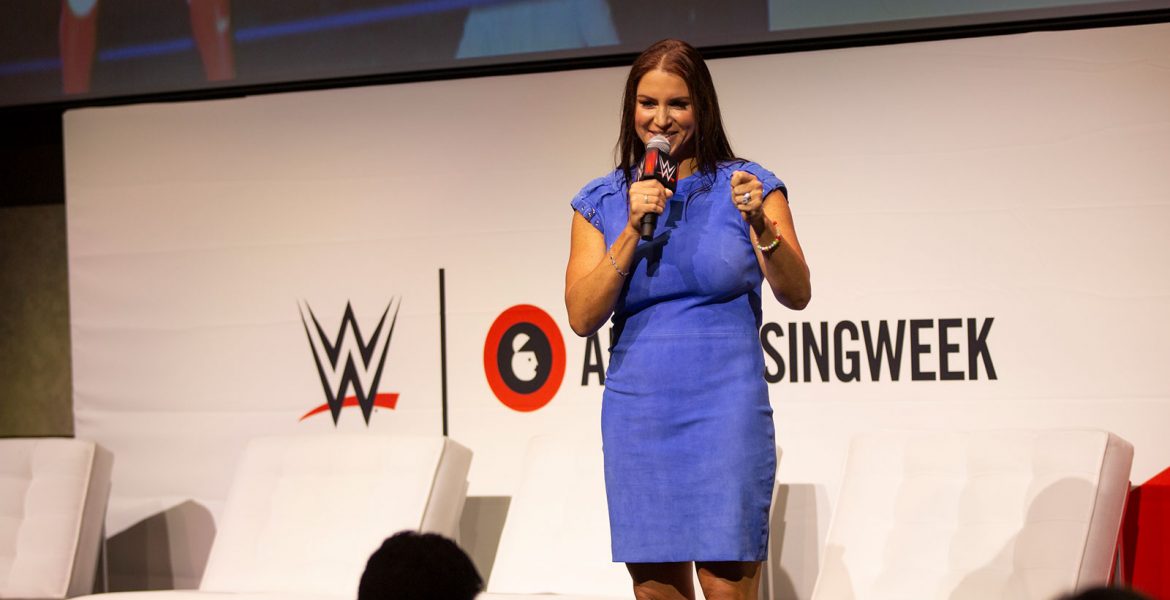One week ago, WWE kicked off Advertising Week New York with our first-ever Thought Leadership breakfast event. We hosted a dynamic panel discussion that shed light on the latest strategies global brands are leveraging to foster authentic consumer engagement and push brand marketing into the future. Moderated by Digiday’s Sahil Patel, the panel included WWE Co-President Michelle Wilson, Cricket Wireless CMO Tiffany Baehman, and Zenith CEO Sean Reardon. Also taking the stage to offer his own personal brand of insight and energy was WWE Superstar The Miz.

The event promised to set the tone for the entire week, delivering insights, predictions, and best practices for brand marketers as they continue to navigate the ever-changing media and technology landscape. Here are three of my biggest takeaways from the conversation:
Media & Tech Have Evolved; the Need for Impact Remains the Same
After listening to the group speak, one theme became immediately clear. The global media and technological landscapes have shifted tremendously over the last decade, but the essence of impactful brand marketing has largely remained the same. Passion and loyalty are still premiums in the eyes of consumers.
Take WWE for example. What was at one time a start-up wrestling promotion in the Northeast U.S. territory has become a global phenomenon in sports entertainment thanks in no small part to the power of storytelling. Whether you consider the company’s earlier days of closed-circuit TV or our robust media platforms our fans engage with today, we always strive to continue our mission of putting smiles on people’s faces the world over. As new technologies and platforms emerge, it is crucial that you implement them in ways that tie back to a marketing goal as old as time itself: positively engage your audience, empower them, and give them a reason to care.
Authenticity’s Definition Depends on the Source
While brand marketers agree being genuine is a defining quality of companies with positive consumer relationships, authenticity can mean different things to different brands and it largely depends on your audience. For Cricket Wireless, CMO Tiffany Baehman vocalized that the company’s impactful marketing efforts have been developed and executed with their unique customer – the value player – in mind.

In our case, the WWE Universe is a vibrant, multi-generational audience spanning more than 180 countries. As The Miz highlighted during the panel, WWE fans can spot inauthenticity from a mile away. In everything we do – from content experimentation to co-branded partner integrations – we strive to maintain a level of legitimacy our fans expect from us and do so in ways that are consistent with our brand. Every week, fans tune into our programming for action, drama and stories; it only makes sense to incorporate these elements into our brand marketing efforts as well (in fact, you may have spotted this approach in our co-branded Colonel Sanders effort with KFC).
Leverage Technology in the Right Ways
There’s no question that brands now have access to more consumer data than ever before thanks to advancements in data analytics, social media and artificial intelligence. But leveraging these technologies to drive useful insights is a long journey and you must feel comfortable embracing disruption along the way.

In our digital economy, leaders are those that disrupt themselves before others do. When we launched WWE Network in February 2014 there were only a handful of streaming services. For years, Pay-Per-View events drove our bottom line until we took a calculated risk by embracing digital technology as a foundation for the company’s future – transforming WWE from a tours-and-tickets business to a global media company. While we had a profitable business strategy, WWE Network allows us to super-serve and better engage with our fans.
Our efforts weren’t without their fair share of challenges. The first year we embraced analytics, we were inundated by a tsunami of data with few processes in place to harvest its value. As Michelle Wilson mentioned during the panel, we adjusted our approach, allowing us to get closer to our fans and provide the programming they asked for. As a result, we developed new programming in the form of our third global brand, NXT, and created a more localized experience for our fans in the UK by creating a championship tournament for the region. These are only two examples of the countless changes and additions we made because of data.

For brand marketers, social media and technology will continue driving new capabilities that allow us to interact with consumers in new and exciting ways. A certain level of discomfort can help a brand grow into new areas and markets, but, as Zenith CEO Sean Reardon pointed out, it’s crucial for marketers to always map innovation back to overarching business objectives and find the right balance between what you can do, and what you should do as a brand.
Whether or not you are leveraging the newest technologies or embracing the always-evolving media trends, one thing remains crucial to connecting with your consumers: storytelling. It is the oldest form of communication, because it is relatable and makes your consumer connect to your message in a more meaningful and authentic way. In a world with a proliferation of goods and services, why should your consumers care about your brands over others?
As Maya Angelou once said, “People will forget what you said, people will forget what you did, but people will never forget how you made them feel”. Having the best product isn’t enough anymore. In order to super-serve your consumer, you need to connect to them in a more personal way.


